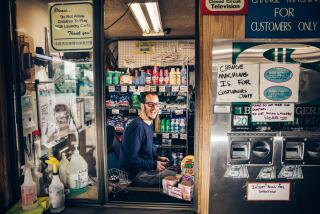Clean Little Secrets
Hereâs what dry-cleaning expert Helen Campbell knows about dirty, wrinkled clothes that you donât: Ink, wine, paint, nail polish and blood are the most stubborn stains; soaking silk in vinegar and water is a bad idea, as are most home remedies for shmutz removal; cotton often comes out better in the wash than if itâs dry-cleaned; linen is the most difficult fabric to press well; and gabardine tends to get shiny if it isnât given a soft press.
For the last 18 years, Campbell has presided over the clothing of a highly particular clientele as manager, then owner of Emerson LaMay Cleaners in Pacific Palisades. She and her staff keep Diana Ross, Billy Crystal, Michelle Pfeiffer, Laker star Kobe Bryant and many other loyal customers looking spiffy. In the Palisades, a community with the friendly feel of a small town, the unfailingly pleasant and cheerful Campbell is so well-regarded that people who move as far as Ojai or Santa Barbara still bring their cleaning in when theyâre in town.
âOur customers have beautiful, expensive clothes, and they want them taken care of in the very best way,â she says.
Over the years, as new fabrics and new products come to market, the waning of the dry-cleaning industry has been predicted with metronomic regularity. But professionals like Campbell donât break a sweat.
âWhen polyester first came out, everyone thought it would do harm to the dry-cleaning business, but it didnât,â says Campbell. âPeople like being taken care of. They donât have time to do it themselves.â
*
Recently, a new home dry-cleaning product from Procter & Gamble came to market amid predictions that it too could cut into the dry-cleaning business. Dryel, a name chosen because it sounds like it can be used in the dryer (which it can), comes in a $10 starter kit that includes a reusable white plastic bag, a bottle of cleaning fluid and four absorbent pads for treating stains, plus a 12-page instructional brochure.
After conspicuous stains are (hopefully) rubbed out, as many as four garments can be put in the bag with a treated cloth and tossed into the dryer, and, 30 minutes later, they are supposed to come out clean. (We tested the product. Clothes actually emerged from the dryer warm and somewhat damp. Some can be hung up and worn without ironing. Anyone enamored of a crisp, pressed look, however, would have to spend some time with an iron to achieve that. The Dryel brochure warned that the product wouldnât remove âharsh stainsâ like blood or ink. In our test, a grease spot faded, but a smudge of chocolate didnât budge. Musty-smelling sweaters emerged smelling like fabric softener.)
Damon Jones, a Procter & Gamble spokesman, says Dryel was never intended to replace dry cleaning completely. âItâs being used mostly for womenâs clothes, and itâs particularly good at removing smoking, cooking and body odors, so itâs good for freshening clothes that arenât heavily soiled.â
According to the companyâs research, only 20% of the clothes taken to the cleaners are actually dirty. Campbell agrees. âPeople just like that fresh, newly pressed look, so they send in their clothes whether theyâre dirty or not,â she says. Campbellâs customers expect anything that comes back from Emerson LaMay to be good to go. She provides a service no dry-cleaner-in-a-bottle ever could: Seams and zippers are routinely inspected and repaired, if necessary. Sensitive buttons are removed before cleaning, then reattached. If clothes are dropped off with damaged or missing buttons, Campbellâs tailor replaces them, even if that means hunting for a match.
Such service has its price. Pickup and delivery, including same-day service Monday through Friday, is free, but cleaning a dress costs $12.95 and up; a suit is $12.95 and up; and a dry-cleaned shirt costs $4.95. Shirts that are washed and hand-finished on the premises, instead of sent out to the laundry, cost $2.95 each.
Attention to detail doesnât come cheap at many of the cityâs other luxury cleaners either, such as Brownâs in Santa Monica and Effreyâs Custom Cleaners in West Hollywood. When one of Campbellâs regular customers decided to save time by taking a pair of ivory wool trousers to a cleaner near her home in Malibu, she was horrified when she picked up pants that had turned khaki. Campbell explained to her distressed client that old cleaning fluid was probably to blame.
âWe keep our filters clean, we separate clothes by color, and we always use fresh solvent,â Campbell says. âWe check the pockets of every garment. If a pen is left in a pocket, it could leak onto a whole load of dry cleaning.â
Emerson LaMayâs stain removal expert has about 15 solutions he can try on a nasty spot. âWhen people spill something on their clothes, their first inclination is to jump up and try to do something,â Campbell says. âThey wind up rubbing the stain in. They should just bring it to us. We hear about so many home remedies and we just shake our heads, because weâve seen how they ruin clothes. The trick with stain removal is getting out the dirt without pulling the color out of the fabric. Not just anyone can do it.â
*
Dryel, on the other hand, cleans a garment for about $1. Beyond the cost factor, Dryel was intended as a boon for people who are so busy that they donât have time to go to the cleaner. If, at midnight, they suddenly decide they want to wear a particular outfit the next day, they can do a load of Dryel.
Know thyself would seem to be the governing principle for would-be Dryel users. Are you a do-it-yourselfer or someone who enjoys being pampered? âSome people bring in everything that was in their suitcase when theyâve come back from a trip,â Campbell says, âjust because they want everything nicely pressed. Some women send us their nightgowns; some men wear a tie or a suit once, then give it to us. They wear it once, then our driverâs there the next morning to pick it up. It isnât really good to clean clothes too often, but they have so many clothes that they wonât wear it again and clean it again for a while.â






